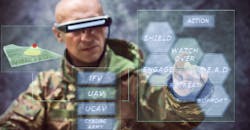Much has been made in recent years how artificial intelligence (AI) is changing our ways of life in all environments, from commercial practices to electronic warfare (EW). Seemingly more than one-half of today’s telephone calls are being made by automated, robotic marketing systems, while almost every new application for credit of any kind questions whether an applicant is a robot.
Robots are performing more of the repetitive tasks in day-to-day life that humans once considered boring, such as making those repetitive marketing phone calls. And, in some cases, such as calls for worthwhile needy charities, those robotic calls can bring a world of good to humans.
Robotic control of autonomous “self-driving” vehicles, such as those guided by advanced driver assistance systems (ADAS), is being projected to make future highways safer as more and more drivers take their hands “off the steering wheel.” Some vehicle manufacturers have even presented plans for autonomous vehicles without steering wheels. They expect that future self-driving vehicles, guided by on-board computers with an abundance of navigational data from vehicular radars and other sensors, will treat drivers more as passengers, resulting in much safer highways.
But what about on the battlefield? What about when faced with complex situational awareness issues and complicated operating environments, when robots and humans team up as troops to face an adversary that also presents armed forces that are a mix of human and robotic soldiers?
Classic science-fiction television shows such as the late 1960s Star Trek series envisioned warfare with man and machine closely interacting, often relying on the starship’s central computer for guidance. The two central characters, very human and emotionally charged Captain James T. Kirk and logic-driven, half-human/half-Vulcan co-pilot Mr. Spock, often debated critical decisions with the ship’s computer as mediator. As is proving true, modern AI technology is helping to develop robotic partners that bring a high degree of logic to the battlefield.
Many nations, including the U.S. and China, are actively pursuing major roles for robotic systems on the battlefield. Unmanned aerial vehicles (UAVs) have been used for some time as information-gathering surveillance tools and even as the means of delivering explosive devices to remote positions.
More advanced, humanoid-type robots could take up a call to duty alongside human partners, with many advantages, including being immune to chemical and biological weapons and being free of the “decision-making clutter” brought about by having emotions. Unlike humans, they can be readily repaired when damaged on the battlefield and be equipped with multiple sensors to far exceed the sensory capabilities of a human soldier. But might the inclusion of emotions bring benefits to a robotic warrior?
Human soldiers learn to count on each other in tight spots, often surpassing normal physical capabilities with a rush of adrenaline to save a comrade under stress or rescue the member of a troop who has become more like family than simply a group of warriors with a common goal. Key decisions on the battlefield are still made by humans even as they rely more on robotic systems such as UAVs as part of an assignment.
Robots can be programmed with impressive precision and positional capabilities through a combination of digital hardware and software, as well as the ability to make fundamental decisions according to a set of predictable situations. But when the number of variables exceeds the limit of a robot’s programming, either a compromise decision or no decision will be made in response to a situation. In that case, the infinite decision-making capabilities of a human commander are required.
Robots offer the capabilities to make a battlefield safer for humans, and they can add logic to a normally emotionally charged environment. Adding programmed emotions might even increase the value of battlefield robotic systems by providing a greater range of decision-making when needed. After all, in a crisis, even Mr. Spock cast aside logic in favor of the emotions bestowed upon him by a human mother.
About the Author
Jack Browne
Technical Contributor
Jack Browne, Technical Contributor, has worked in technical publishing for over 30 years. He managed the content and production of three technical journals while at the American Institute of Physics, including Medical Physics and the Journal of Vacuum Science & Technology. He has been a Publisher and Editor for Penton Media, started the firm’s Wireless Symposium & Exhibition trade show in 1993, and currently serves as Technical Contributor for that company's Microwaves & RF magazine. Browne, who holds a BS in Mathematics from City College of New York and BA degrees in English and Philosophy from Fordham University, is a member of the IEEE.

